Ruth Bader Ginsburg: A Luminary Donning a Lace Collar and Judicial Robes
Opinion
@nytmag
A visionary and globally recognized figure, Justice Ruth Bader Ginsburg served as a prominent figure in the pursuit of equality. Photo Courtesy of @nytmag
September 29, 2020
Women of all ages had found their heroic leader, the figurehead of strengthened women’s rights and a truly vividly intelligent and brave woman who defied years of sexism. A woman who went on to have a powerful influence in the Supreme Court, altering years of conservative precedents and embodying democracy, justice, and what she knew was right, even if her voice stood out against the majority. Ruth Bader Ginsburg, a revolutionary icon, passed away on Sept. 18 after 27 years serving on the Supreme Court.
We remember that Justice Ruth Bader Ginsburg, through times where her sparkling intellect and definitive precision in law were challenged and undermined solely due to her gender, protected and upheld rights for every American woman. We owe her so much. Her status as the second female Supreme Court justice and a nationally and globally recognized leader did so much for enabling women to pursue law and such career paths. She completely altered legislation and pushed for progressive politics. In New York, a statue called the ‘Fearless Girl Statue’ wears a lace collar around its neck, a nod to Justice Ginsburg’s iconic lace collar on her judicial robes, saluting the luminary who emboldened women’s rights. As passersby can see, her influence is felt throughout women and girls across the country. She was and is their brave soldier who triumphantly fought great battles to ensure them a greater future. She went into a chess game in a politically fervent DC, her head held high and her composure calm and collected. Her death signals a passing of her efforts to American women to continue her legacy, one that she formed with courage and one that’s impact reaches a national scale.
With her passionate commitment to equality and strong leadership, she spearheaded civil rights battles, successfully ensuring that women have greater rights than before in various environments; their homes, collegiate/educational settings, and workplaces. Justice Ginsburg’s steady decision making and ability to uphold her dissenting decision in many cases enabled her to be the upholder of liberal values in a majority conversative panel as well as a voice of reason that brought respect by both parties.
As a young woman she was an excellent student who attended Cornell University as well as both Colombia and Harvard Law School, which was a rarity in the 50’s where gender stereotypes were increasingly persistent and a woman receiving a higher education was straying from the norm.While a university student at Harvard she juggled college, the pressing illness of her husband, as well as taking care of her young child. Simultaneously, she received top grades that outranked her male counterparts. She and her husband were both in the law field, and he served as her greatest supporter and championed her success. Despite her excellent educational status and ethic, she was rejected from law firms due to her gender.
Her journey to the Supreme Court consisted of many cases regarding civil rights and discrimination on the basis of sex. In her selection of the cases she defended, she singled out cases that would illustrate how society’s sexist stereotypes for both women and men contradicted the nature of the constitution and in turn, our democracy. Her commitment to these cases gained her respect and credibility.
She worked as a teacher at Rutgers Law School and made history when she later became the first tenured female professor at Columbia Law School. During her time as a Supreme Court justice, one of her most notable cases was Obergefell v. Hodges in 2015 which successfully legalized same-sex marriages throughout the nation with the vote of her and her fellow liberal leaning justices. Another was United States v. Virginia in 1996, which served as a definitive turning point in making sure women had equal access to the same collegiate opportunities as men. Even before ascending to the Supreme Court she had considerable sway. In the 1970s, she helped the passage of the Equal Credit Opportunity Act which promised women the ability to own a credit card, sign a mortgage, and have their own bank accounts without a man. She and a colleague facilitated the passage of the Pregnancy Discrimination Act which allowed women to feel secure in their job and gave them immunity to termination if employers threatened their jobs because they were pregnant or wanted to have children. These among the many acts and laws she helped to pass altered women’s rights immensely and paved the way for greater triumphs in the struggle for equality. Her legacy can also be seen in the Women’s Rights Project which further emphasized the need for gender equality specified in the words of the Constitution that we live by.
Roe v. Wade, perhaps one of the most critical Supreme Court decisions that may be upturned due to the passing of the leading liberal justice, may face strengthened opposition by the Republican faction. Roe v. Wade nationally legalized abortion with varied state legislations but an overarching protection for those seeking it. In an article by the New York Times, Justice Ginsburg’s critical viewing of Roe v. Wade was not due to a, “disapproval of abortion access,” but instead, “ her wholehearted commitment to it”. Its structure was what she disliked, that it, “focused on the wrong argument — that restricting access to abortion violated a woman’s privacy,” instead of ,“ a protection of the right to abortion on the basis that restricting it impeded gender equality.” She wanted to solidify the argument so that it would be constitutionally sound, and therefore much more difficult to overturn and challenge.
With her passing, the increasing political uncertainty the nation is presented with is amplified as Republican members scramble to now fill her vacant seat in the Supreme Court. This is their attempt to uphold conservative influence in the court even if President Donald Trump loses re-election. In 2016, as then President Barack Obama attempted to fill a vacant Supreme Court position, he faced scrutiny and contradiction from Republicans, blocking his ability to select a candidate for the Supreme Court with Senator Mitch McConnell claiming that, “the American people should have a voice in the selection of their next Supreme Court Justice,” even as President Obama’s term was longer than President Trump’s whose term has less than 50 days til the 2020 Presidential Election.
Though a majority of this youthful generation do not yet have the privilege of being able to cast their votes for who they want to lead this country, this election year more than before has a great amount at stake. Will the nation again lead the Trump campaign to victory, one that lauds Republicans waiting less than two hours after the death of a national figure to announce their replacement? This morally unfeeling and politically backhanded action signifies that the disagreement between political parties has now transformed into discourse where humanity is squandered in attempts to gain political leverage. Ruth Bader Ginsburg fought for justice, not to appease one party or the other. That is the mark of a supreme advocate of the law, not a politician.
Through Ruth Bader Ginsburg’s life story we must find motivation. Be unafraid and willing to make change. Without strong women like Justice Ginsburg we wouldn’t have protections and rights that seem guaranteed to us now.



